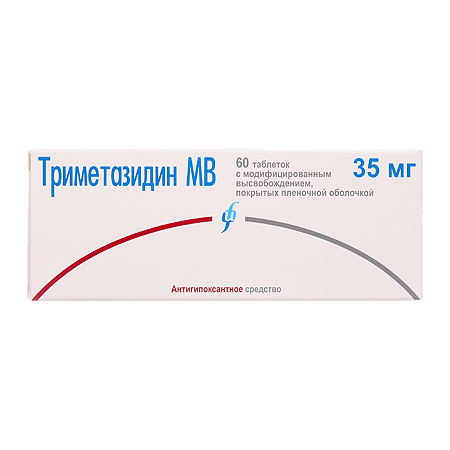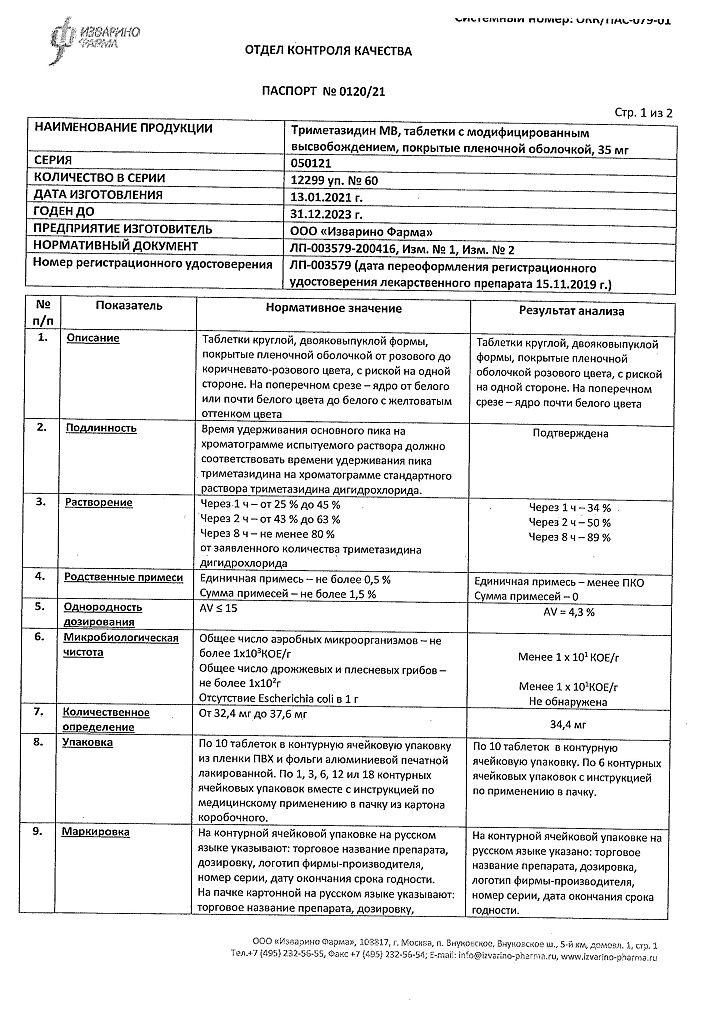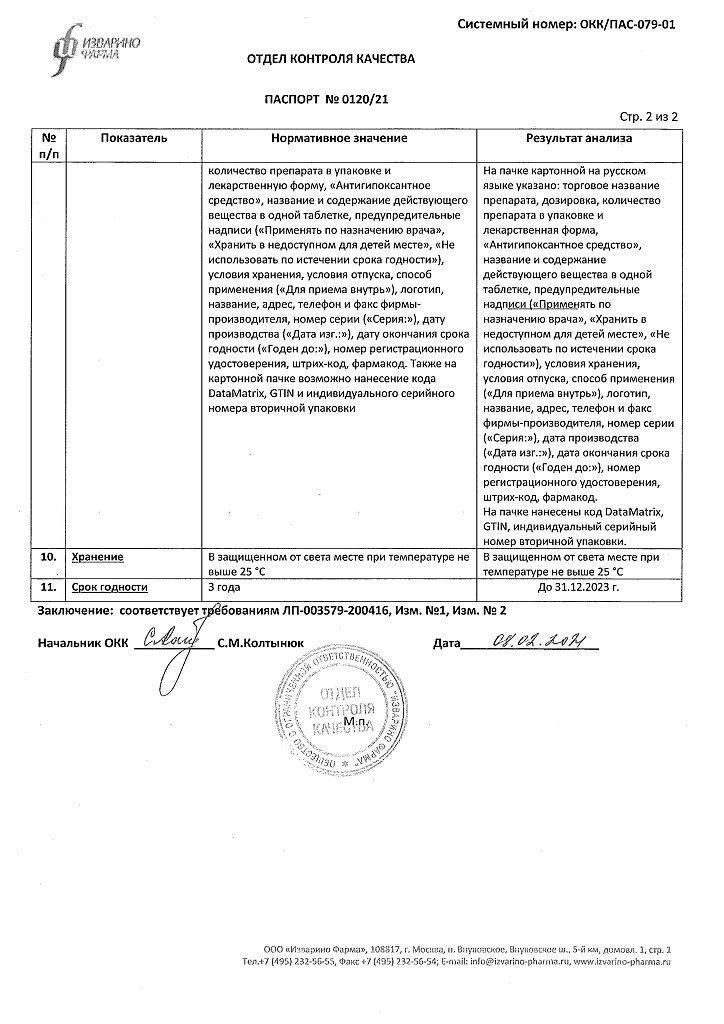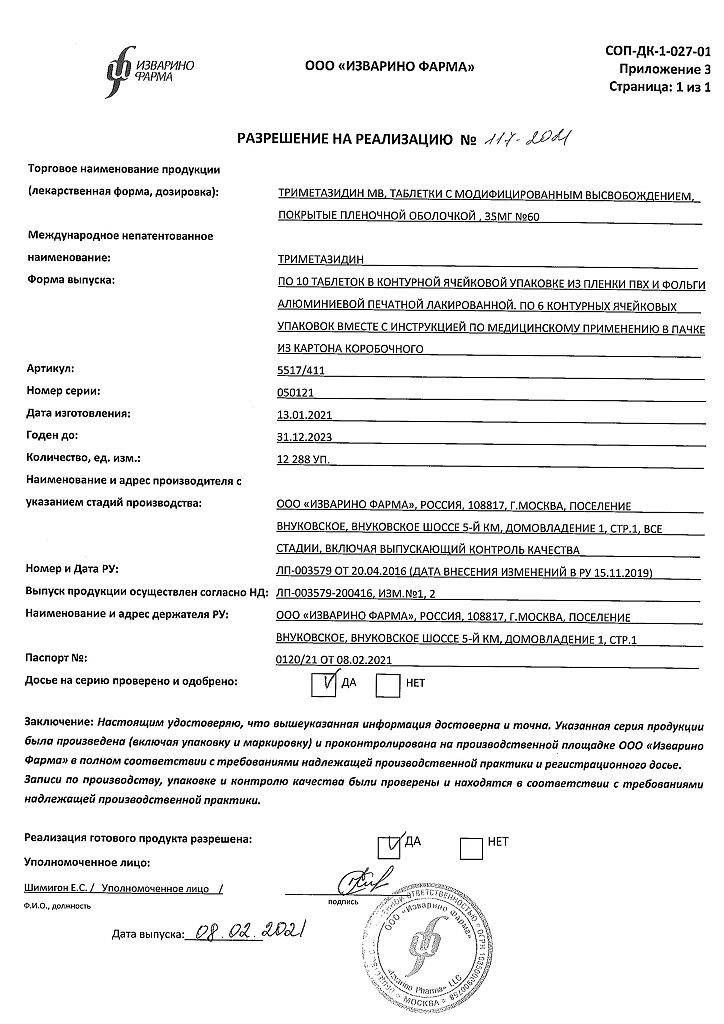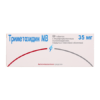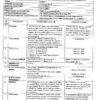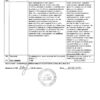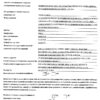No products in the cart.
Trimetazidine MB, 35 mg 60 pcs
€18.35 €15.29
Description
Pharmacodynamics
It has an antihypoxic effect. Trimetazidine prevents reduction of intracellular adenosine triphosphate (ATP) concentration by maintaining energy metabolism of cells under hypoxia.
In this way, the drug ensures normal functioning of membrane ion channels, transmembrane transport of potassium and sodium ions and preservation of cellular homeostasis. Trimetazidine inhibits fatty acid oxidation through selective inhibition of the enzyme 3-ketoacyl-CoA-thiolase (3-CAT) mitochondrial long-chain fatty acid isoform, which leads to increased glucose oxidation and accelerated glycolysis with glucose oxidation, which leads to myocardial protection from ischemia.
The switch of energy metabolism from fatty acid oxidation to glucose oxidation underlies the pharmacological properties of trimetazidine.
Trimetazidine has been experimentally confirmed to have the following properties:
- maintains energy metabolism of cardiac and neurosensory tissues during ischemia;
- reduces the severity of intracellular acidosis and changes in transmembrane ion flow that occur during ischemia;
- reduces the size of myocardial damage;
- does not directly affect hemodynamic parameters.
In patients with angina pectoris, trimetazidine:
- increases coronary reserve, thereby delaying the onset of exercise-induced ischemia from day 15 of therapy;
- limits exercise-induced blood pressure fluctuations without significant changes in heart rate;
- reduces the frequency of angina attacks and the need for short-acting nitroglycerin;
- improves left ventricular contractile function in patients with coronary dysfunction.
Pharmacokinetics
After oral administration, trimetazidine is absorbed from the gastrointestinal tract and reaches maximum plasma concentration after approximately 5 hours. Above 24 hours, plasma concentrations remain above the 75% concentration determined after 11 hours. The equilibrium state is reached after 60 hours. Food intake does not affect the bioavailability of trimetazidine.
The volume of distribution is 4.8 l/kg, which indicates good distribution of trimetazidine in tissues (the degree of binding to plasma proteins is quite low, about 16 % in vitro). Trimetazidine is mainly excreted by the kidneys, mainly unchanged. Renal clearance of trimetazidine directly correlates with creatinine clearance (CK), hepatic clearance decreases with patient age.
Indications
Indications
– Coronary heart disease: prevention of angina attacks (in complex therapy);
– Chorioretinal vascular disorders;
– Cochleo-vestibular disorders of ischemic nature (tinnitus, hearing impairment, dizziness).
Pharmacological effect
Pharmacological effect
Pharmacodynamics
Has an antihypoxic effect. Trimetazidine prevents a decrease in intracellular adenosine triphosphate (ATP) concentration by maintaining the energy metabolism of cells in a state of hypoxia.
Thus, the drug ensures the normal functioning of membrane ion channels, transmembrane transport of potassium and sodium ions and the preservation of cellular homeostasis. Trimetazidine inhibits the oxidation of fatty acids due to the selective inhibition of the enzyme 3-ketoacyl-CoA thiolase (3-CAT) of the mitochondrial long-chain isoform of fatty acids, which leads to increased oxidation of glucose and acceleration of glycolysis with oxidation of glucose, which determines the protection of the myocardium from ischemia.
The switch of energy metabolism from fatty acid oxidation to glucose oxidation underlies the pharmacological properties of trimetazidine.
It has been experimentally confirmed that trimetazidine has the following properties:
supports energy metabolism of the heart and neurosensory tissues during ischemia;
reduces the severity of intracellular acidosis and changes in transmembrane ion flow that occur during ischemia;
reduces the level of migration and infiltration of polynuclear neutrophils in ischemic and reperfused heart tissues;
reduces the size of myocardial damage;
does not have a direct effect on hemodynamic parameters.
In patients with angina, trimetazidine:
increases coronary reserve, thereby slowing down the onset of ischemia caused by physical activity, starting from the 15th day of therapy;
limits exercise-induced blood pressure fluctuations without significant changes in heart rate;
reduces the frequency of angina attacks and the need for short-acting nitroglycerin;
improves contractile function of the left ventricle in patients with ischemic dysfunction.
Pharmacokinetics
After oral administration, trimetazidine is absorbed from the gastrointestinal tract and reaches maximum plasma concentrations after approximately 5 hours. Over 24 hours, the concentration in the blood plasma remains at a level exceeding 75% of the concentration determined after 11 hours. The equilibrium state is reached after 60 hours. Food intake does not affect the bioavailability of trimetazidine.
The volume of distribution is 4.8 l/kg, which indicates good distribution of trimetazidine in tissues (the degree of binding to plasma proteins is quite low, about 16% in vitro). Trimetazidine is excreted mainly by the kidneys, mainly unchanged. Renal clearance of trimetazidine directly correlates with creatinine clearance (CC), hepatic clearance decreases with patient age.
Special instructions
Special instructions
It is not used to relieve attacks of angina pectoris and is not indicated for the initial course of treatment of unstable angina or myocardial infarction, as well as in preparation for hospitalization or in its first days.
If an attack of angina occurs, treatment (drug therapy or revascularization) should be reviewed and adapted.
Impact on the ability to drive vehicles. Wed and fur.:
The use of the drug does not affect the ability to drive a car or perform work that requires a high speed of mental and physical reactions.
Active ingredient
Active ingredient
Trimetazidine
Composition
Composition
1 extended-release film-coated tablet contains:
Active substance:
trimetazidine dihydrochloride 35 mg.
Excipients:
calcium hydrogen phosphate dihydrate,
microcrystalline cellulose,
colloidal silicon dioxide (aerosil),
hydroxypropylcellulose Klucel LF,
hydroxypropyl methylcellulose,
Plasdon S-630,
magnesium stearate.
Film shell composition:
Selekote (hydroxypropyl methylcellulose, plasdon S-630, polyethylene glycol, talc, red iron oxide, titanium dioxide).
Contraindications
Contraindications
– Hypersensitivity to any component of the drug;
– Renal failure (creatinine clearance less than 15 ml/min.);
– Severe liver dysfunction;
– Pregnancy;
– Breastfeeding period;
– Age up to 18 years (efficacy and safety have not been established);
– Patients with lactase deficiency, galactosemia or glucose-galactose malabsorption syndrome.
Side Effects
Side Effects
Rarely – nausea, vomiting, allergic reactions are possible.
Overdose
Overdose
Currently, no cases of drug overdose have been reported.
Storage conditions
Storage conditions
In a place protected from light at a temperature not exceeding 25°C. Keep out of the reach of children.
Shelf life
Shelf life
2 years.
Manufacturer
Manufacturer
Izvarino Pharma, Russia
Additional information
| Shelf life | 2 years. |
|---|---|
| Conditions of storage | In the dark place at a temperature not exceeding 25 ° C, Keep out of reach of children. |
| Manufacturer | Izvarino Pharma, Russia |
| Medication form | controlled release tablets |
| Brand | Izvarino Pharma |
Related products
Buy Trimetazidine MB, 35 mg 60 pcs with delivery to USA, UK, Europe and over 120 other countries.

